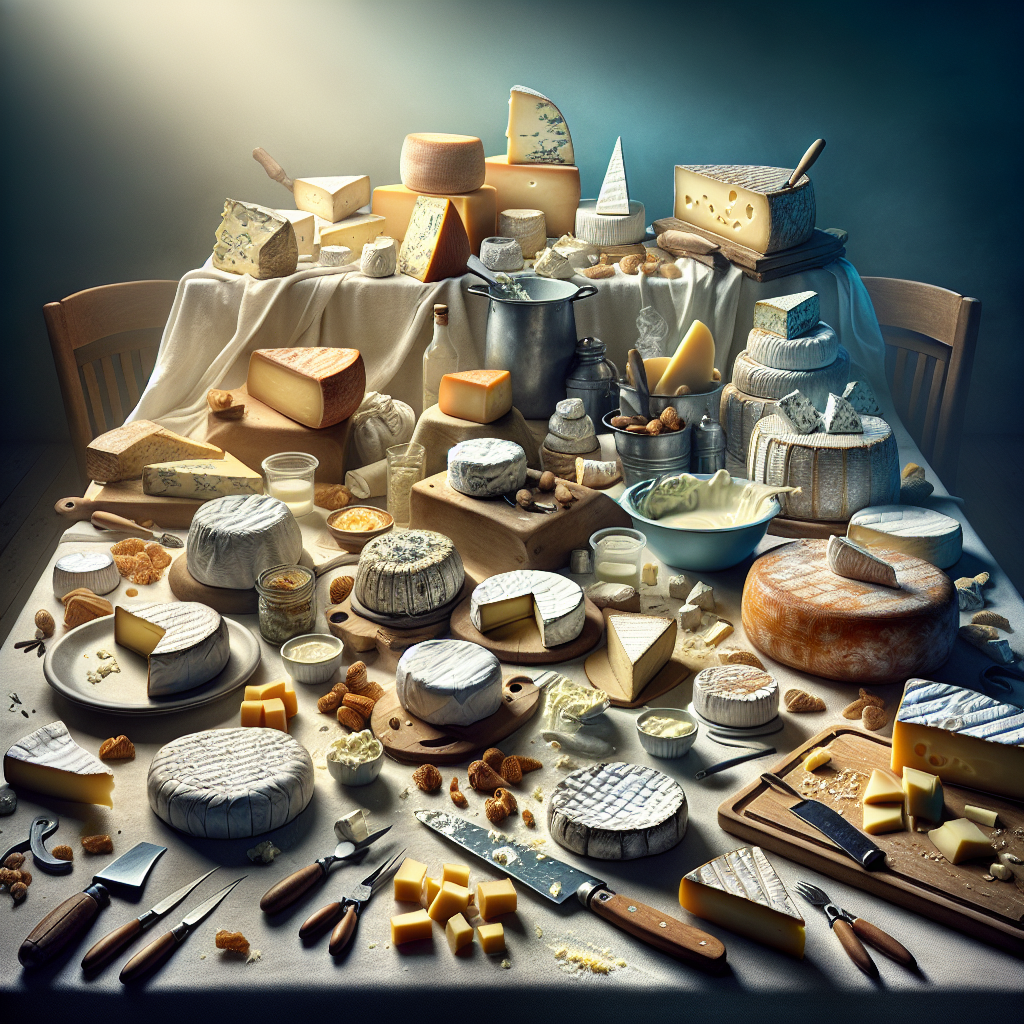Immerse yourself in the rich heritage of French cheese as we take you on a culinary journey from Brie to Roquefort. At Tastepan.com, we are passionate about exploring the diverse world of food culture and traditions. Join us as we delve into the fascinating history, regional variations, and mouthwatering flavors that make French cheese a true gastronomic delight. From the creamy indulgence of Brie to the bold tanginess of Roquefort, prepare to have your taste buds tantalized and your appreciation for the global tapestry of flavors deepened.
Craft of French Cheese

Introduction to French Cheese
Welcome to the wonderful world of French cheese! France is renowned for its exquisite cheeses, which have become an integral part of French cuisine and culture. With a history dating back centuries, French cheese is a true testament to the skill and craftsmanship of generations of cheese makers. From soft and creamy Brie to tangy and pungent Roquefort, the variety and quality of French cheeses is unparalleled. In this article, we will explore the different regions of French cheese, the various types of French cheese, and delve into the specifics of some of the most beloved varieties.
Importance of French Cheese in French Cuisine
French cheese plays a vital role in French cuisine, anchoring many traditional dishes and serving as a versatile ingredient in countless others. From the humble baguette topped with a slice of Camembert to the rich and decadent classic dish, Coq au Vin, cheese is often the star of the show. It adds depth, complexity, and a touch of indulgence to meals, making them truly satisfying. Furthermore, French cheese pairs effortlessly with wine, enhancing both flavors and creating a harmonious dining experience. The art of French cheese-making is deeply ingrained in French culinary traditions and is a testament to their dedication to high-quality, flavorful food.

Cheese Regions in France
France is divided into several regions, each with its own distinct cheese-making traditions and specialties. These regions are not only geographic divisions but also have unique microclimates, soils, and terroirs that contribute to the flavors and characteristics of their cheeses. Some notable cheese regions in France include Normandy, Burgundy, the Auvergne, and the region of Roquefort. These regions have a long history of producing exceptional cheeses and continue to uphold the traditions and techniques passed down through generations.
Terroir in French Cheese Production
Terroir is a term often used in the cheese-making process in France. It refers to the environmental factors, such as soil composition, climate, and local flora, that contribute to the unique flavors and characteristics of cheese. The terroir of a specific region or farm plays a significant role in determining the taste, texture, and aroma of the cheese. For example, the lush green pastures of Normandy produce buttery and rich cheeses, while the rugged terrain of the Basque region gives rise to tangy and flavorful options. The concept of terroir is deeply ingrained in French cheese-making, highlighting the importance of the land and the environment in the craft.

Types of French Cheese
French cheese can be classified into various types based on their texture, milk source, and production methods. Let’s explore the main types of French cheese:
Soft Cheeses
Soft cheeses are known for their creamy, rich texture and delicate flavors. They are typically aged for a short period, resulting in a soft and gooey center. Examples of popular soft French cheeses include Brie, Camembert, and Saint-Marcellin.
Hard Cheeses
Hard cheeses, often aged for longer periods, have a firm and crumbly texture. They boast complex flavors that develop over time, ranging from nutty to sharp. Comté is a prime example of a beloved French hard cheese, celebrated for its distinct taste and versatility.
Blue Cheeses
Blue cheeses have a distinctive blue or green mold running through them, which gives them their characteristic flavor and aroma. Roquefort is the epitome of a classic French blue cheese, with its intense and tangy profile that pairs beautifully with fruit and honey.
Goat Cheeses
Goat cheeses, also known as chèvre, are made from goat’s milk and offer a wide range of flavors and textures. They can be creamy, crumbly, or semi-hard, with flavors ranging from mild and grassy to strong and earthy. Munster is a well-known French goat cheese that showcases the versatility and complexity of goat’s milk.
Brie
History of Brie Cheese
Brie cheese, originating from the region of the same name in northern France, has a history that dates back over a thousand years. It is believed to have been enjoyed by Charlemagne, the famous medieval emperor. Brie gained popularity and became a staple in French cuisine during the reign of King Louis XVI. Today, it is a beloved cheese enjoyed both in France and around the world.
Production Process of Brie Cheese
Brie cheese is made from cow’s milk and is produced using traditional methods. The process begins with the collection of fresh, high-quality milk, which is then warmed and mixed with cultures and rennet to promote the curdling process. The curds are cut, drained, and placed into molds, where they are pressed to remove excess whey. After several weeks of aging, during which the cheese develops its characteristic bloomy rind, it is ready to be enjoyed.
Characteristics and Flavors
Brie cheese is known for its velvety texture and mild, buttery flavors. Its pale interior reveals a creamy and oozy center that melts in your mouth. The rind of Brie develops naturally during the aging process and adds depth to the overall flavor profile. It has a pleasant earthy aroma and a delicate tang that complements the rich interior. Brie is a versatile cheese that can be enjoyed on its own, spread on a fresh baguette, or used in a variety of dishes.
Popular Brie Cheese Dishes
Brie cheese is a versatile ingredient in both sweet and savory dishes. It pairs beautifully with fruits like apples, pears, and berries, creating a perfect balance of flavors. Baked Brie with honey and nuts is a popular appetizer that showcases the cheese’s creamy texture and subtle sweetness. Additionally, Brie is often used in sandwiches, omelets, and salads, adding a touch of decadence and richness to the dish.
Camembert
Origin and History of Camembert Cheese
Camembert cheese, hailing from the Normandy region of France, has a history that can be traced back to the late 18th century. It was created by Marie Harel, a local farmer, who developed the recipe after receiving advice from a priest from Brie. The cheese gained popularity and became a household name in France and beyond.
Camembert Cheese Production
Camembert cheese is made from cow’s milk and follows a similar production process to Brie. Fresh milk is heated, cultures and rennet are added to promote coagulation, and the curds are cut and drained. However, Camembert is typically made in smaller, wheel-shaped molds, which give it its distinctive shape. The cheese is then aged for a few weeks, during which the rind develops and the flavors mature.
Flavors and Pairings
Camembert cheese boasts a creamy, gooey texture and a slightly more robust flavor compared to Brie. Its rind is bloomy and white, while the interior has a creamy gold hue. The flavors are earthy, with hints of mushroom and nuttiness. When ripe, Camembert has a complex aroma that is both inviting and distinct. It pairs beautifully with crispy baguette, tart apples, and even a glass of dry cider or champagne.
Roquefort
Introduction to Roquefort Cheese
Roquefort cheese holds a special place in the world of French cheese, being one of the oldest known blue cheeses. Made from sheep’s milk, Roquefort has a unique and intense flavor that has captivated cheese lovers for centuries. It is named after the village of Roquefort-sur-Soulzon in the south of France.
Roquefort Cheese Production
Roquefort cheese is made using a specific and intricate method known as “piercing” or “needling.” The milk is collected exclusively from the Lacaune breed of sheep, which graze in the rugged lands surrounding Roquefort. After the cheese is formed, it is aged in natural limestone caves for a minimum of three months. The caves provide the ideal conditions for the growth of the Penicillium roqueforti mold, which gives Roquefort its signature blue veins.
Unique Characteristics
What sets Roquefort cheese apart is its distinct blue mold and its crumbly yet creamy texture. The blue veins running through the cheese create a beautiful marbled appearance and provide a powerful, tangy flavor. Roquefort is known for its sharp and intense taste, balancing the richness of the sheep’s milk with a pleasant saltiness. Its complex and robust flavors make it a favorite for those who enjoy bold and distinctive cheeses.
Culinary Uses of Roquefort Cheese
Roquefort cheese is often savored on its own, paired with a crusty baguette or gourmet crackers. It also pairs exceptionally well with fruits such as pears and figs, creating a delightful combination of sweet and savory flavors. Roquefort is a staple ingredient in many classic French dishes, such as salads, quiches, and creamy sauces. Its strong flavors add depth and complexity to these dishes, making them truly memorable.
Comté
Background of Comté Cheese
Comté cheese, originating from the Jura Mountains in eastern France, is one of the most popular and widely consumed French cheeses. It has a long history and is deeply rooted in the traditions of the region. Comté gained recognition as a Protected Designation of Origin (PDO) cheese in 1952, ensuring that only cheeses produced in accordance with strict regulations can bear the name.
Traditional Comté Cheese-Making Methods
Comté cheese is made from unpasteurized cow’s milk collected from local, Montbéliarde and French Simmental cows. The milk is collected twice daily and transported to the cheese-making facilities, where it undergoes a meticulous production process. The curdling of the milk is initiated using natural starter cultures and rennet, and the curds are gently cut and heated. After the curds are drained and pressed, the cheese is aged for several months, resulting in a cheese with complex flavors and a firm yet silky texture.
Tasting Notes and Pairings
Comté cheese is known for its wide range of flavors, which can vary depending on the age and maturation of the cheese. Young Comté has a delicate, nutty sweetness, while older Comté develops a richer, caramel-like flavor. The texture is smooth and pliable, with occasional crunchy crystals that add a delightful textural element. Comté pairs beautifully with a variety of accompaniments, including nuts, dried fruits, and crusty bread. It is also a versatile cheese for cooking, adding depth and richness to gratins, fondues, and quiches.
Munster
History and Origins of Munster Cheese
Munster cheese, originating from the Alsace region in northeastern France, has a rich history that can be traced back to the Middle Ages. It takes its name from the Munster Valley, a picturesque area known for its lush green pastures and traditional cheese-making techniques. Munster cheese has become synonymous with the region’s gastronomy and is highly regarded for its unique flavors.
Munster Cheese Production
Munster cheese is made from cow’s milk, predominantly sourced from the local Vosges Mountains. The milk is heated and mixed with a combination of lactic acid bacteria and rennet to promote coagulation. After coagulation, the curds are cut and stirred before being poured into molds and pressed. The cheese is then aged for several weeks, during which time it develops its characteristic reddish rind and distinctive flavors.
Flavors and Culinary Applications
Munster cheese boasts a pungent yet captivating aroma, with flavors ranging from creamy and buttery to tangy and earthy. It has a semi-soft texture with a luscious interior that becomes oozy and rich as it nears maturity. Munster pairs wonderfully with hearty bread, such as rye or sourdough, and is often enjoyed with pickles, sauerkraut, or cold cuts. It is also a popular ingredient in traditional Alsatian dishes, such as tarte flambée and choucroute garnie.
Reblochon
Reblochon Cheese: A Brief Overview
Reblochon cheese, hailing from the French Alps, is a creamy and flavorful cheese with a long-standing history in alpine cheese-making. It originated in the Haute-Savoie region during the Middle Ages and has remained a beloved cheese in the region ever since. Reblochon cheese has achieved recognition as an Appellation d’Origine Contrôlée (AOC) cheese, guaranteeing its quality and authenticity.
Reblochon Cheese-Making Process
Reblochon cheese is made from raw cow’s milk, primarily sourced from local Abondance or Tarentaise cows. The milk is heated and coagulated using rennet, forming a curd that is then cut and stirred. The curds are drained, gently pressed, and placed into circular molds. The cheese is then washed with brine to promote the development of the characteristic reddish-orange rind and enhance the complex flavors. Reblochon is aged for a minimum of four weeks, allowing the flavors to mature and the texture to become creamy and supple.
Tasting Profile and Serving Suggestions
Reblochon cheese offers a delightful combination of creamy, nutty flavors and a luxurious, velvety texture. It has a mild yet distinct aroma, and its rind adds a slightly earthy undertone to the overall experience. Reblochon pairs beautifully with crusty bread, cured meats, and fresh fruits, creating a delectable balance of flavors. It is also a star ingredient in iconic French dishes such as tartiflette, a hearty potato and cheese casserole that showcases the melty and indulgent qualities of Reblochon.
Saint-Marcellin
Introduction to Saint-Marcellin Cheese
Saint-Marcellin cheese, originating from the Rhône-Alpes region of France, is a small, soft, and creamy cheese that has gained a loyal following for its irresistible flavors. It takes its name from the town of Saint-Marcellin, where it has been produced for centuries. Saint-Marcellin is celebrated for its rustic charm and delicate characteristics.
Saint-Marcellin Cheese Production
Saint-Marcellin cheese is made from cow’s milk and is produced using traditional methods. The milk is warmed and mixed with acidifying bacteria and rennet, allowing the curds to form. After the curds are cut and drained, they are lightly salted and poured into small molds. The cheese is then aged for a few weeks, during which time it develops its bloomy and wrinkled rind and becomes soft and creamy on the inside.
Flavor Profile and Serving Ideas
Saint-Marcellin cheese offers a rich and indulgent flavor profile, with a tangy and slightly salty taste that complements its creamy texture. The cheese has a velvety, melt-in-your-mouth consistency and a pleasant earthy aroma. Saint-Marcellin pairs beautifully with crusty bread or crackers and can be enjoyed on its own or with a touch of honey or fruit preserves. It also adds a touch of elegance to salads and appetizers, bringing a burst of flavor to every bite.
In conclusion, French cheese is a testament to the craftsmanship and dedication of French cheese makers. From the soft and creamy Brie to the tangy and robust Roquefort, each variety tells a story rooted in tradition and terroir. Whether enjoyed on its own or incorporated into a variety of dishes, French cheese brings a taste of France’s rich culinary heritage to your plate. So, go ahead and indulge in the craft of French cheese, exploring the different regions, types, and flavors that make it a true delight for cheese lovers worldwide.

